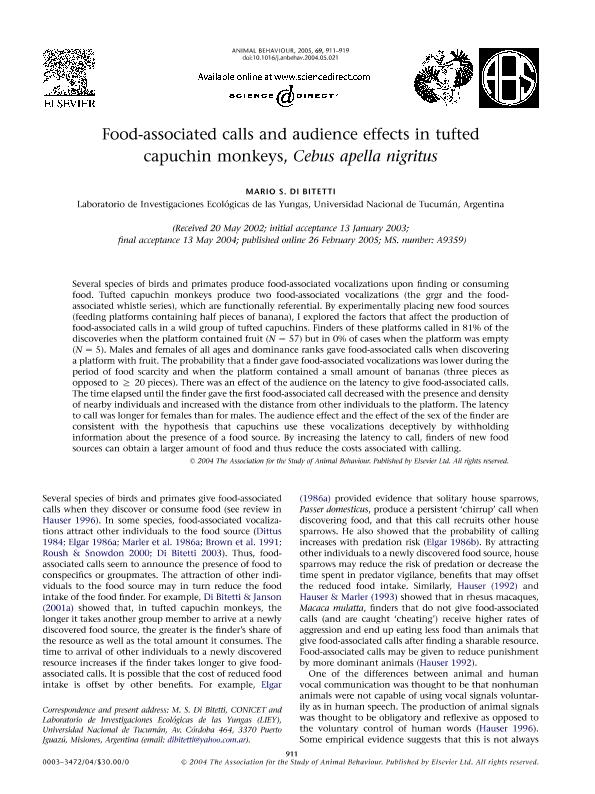Artículo
Food-associated calls and audience effects in tufted capuchin monkeys, Cebus apella nigritus
Fecha de publicación:
04/2005
Editorial:
Academic Press Ltd - Elsevier Science Ltd
Revista:
Animal Behaviour
ISSN:
0003-3472
Idioma:
Inglés
Tipo de recurso:
Artículo publicado
Clasificación temática:
Resumen
Several species of birds and primates produce food-associated vocalizations upon finding or consuming food. Tufted capuchin monkeys produce two food-associated vocalizations (the grgr and the food-associated whistle series), which are functionally referential. By experimentally placing new food sources (feeding platforms containing half pieces of banana), I explored the factors that affect the production of food-associated calls in a wild group of tufted capuchins. Finders of these platforms called in 81% of the discoveries when the platform contained fruit (N = 57) but in 0% of cases when the platform was empty (N = 5). Males and females of all ages and dominance ranks gave food-associated calls when discovering a platform with fruit. The probability that a finder gave food-associated vocalizations was lower during the period of food scarcity and when the platform contained a small amount of bananas (three pieces as opposed to ≥ 20 pieces). There was an effect of the audience on the latency to give food-associated calls. The time elapsed until the finder gave the first food-associated call decreased with the presence and density of nearby individuals and increased with the distance from other individuals to the platform. The latency to call was longer for females than for males. The audience effect and the effect of the sex of the finder are consistent with the hypothesis that capuchins use these vocalizations deceptively by withholding information about the presence of a food source. By increasing the latency to call, finders of new food sources can obtain a larger amount of food and thus reduce the costs associated with calling.
Archivos asociados
Licencia
Identificadores
Colecciones
Articulos(CCT - NORDESTE)
Articulos de CTRO.CIENTIFICO TECNOL.CONICET - NORDESTE
Articulos de CTRO.CIENTIFICO TECNOL.CONICET - NORDESTE
Citación
Di Bitetti, Mario Santiago; Food-associated calls and audience effects in tufted capuchin monkeys, Cebus apella nigritus; Academic Press Ltd - Elsevier Science Ltd; Animal Behaviour; 69; 4; 4-2005; 911-919
Compartir
Altmétricas




